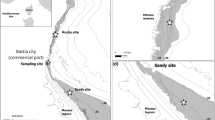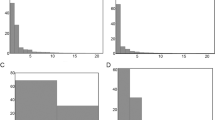Abstract
Our knowledge of why animals orientate in specific directions is less than for any other type of distribution; this is especially true for intertidal organisms. Understanding the behaviour of intertidal organisms on vertical/near-vertical surfaces is important as the relative abundance of these surfaces will increase with elevated sea levels. Orientation by marine organisms is a fundamental behaviour, but most studies have addressed environmental influences on orientation. It is equally true that habitat properties, intraspecific interactions and intrinsic individual variation will be important. Populations of the limpet Cellana tramoserica exhibit a downwards bias in orientation on steeply sloped substrata (>60°), but orientation varies among individuals. We tested whether differences in orientation are explained by inter-individual behavioural variations, in a population examined for 4 months in each of 2 years. Significantly, more limpets than expected consistently orientated downwards (“downwards facing limpets”) and additionally the majority of limpets were consistently found on steeply sloped substrata. The number of “downwards facing limpets” we found was not sufficiently large enough to completely explain population-level patterns of orientation, as only 8 % of limpets consistently faced downwards compared to 39 % of a population facing downwards at any given point in time. Also, individuals that consistently occupied steeply sloped substrata were no more likely to orientate downwards than others. We suggest that intrinsic inter-individual variation among limpets influences orientation. The temporal variation in individual orientation observed emphasises the requirement for adequate temporal replication in experiments before proposing causal explanations.

Similar content being viewed by others
References
Alexander JE, Covich AP (1991) Predation risk and avoidance behavior in 2 freshwater snails. Biol Bull 180:387–393
Benedetti-Cecchi L, Bulleri F, Cinelli F (2000) The interplay of physical and biological factors in maintaining mid-shore and low-shore assemblages on rocky coasts in the north–west Mediterranean. Oecologia 123:406–417
Bohorquez-Alonso ML, Font E, Molina-Borja M (2011) Activity and body orientation of Gallotia galloti in different habitats and daily times. Amphibia-Reptilia 32:93–103
Bortolotti GR, Stoffel MJ, Galvan I (2011) Wintering Snowy Owls Bubo scandiacus integrate plumage colour, behaviour and their environment to maximize efficacy of visual displays. Ibis 153:134–142
Branch GM (1975) Mechanisms reducing intraspecific competition in Patella spp.—migration, differentiation and territorial behavior. J Anim Ecol 44:575–600
Branch GM (1981) The biology of limpets, physical factors, energy flow and ecological interactions. Oceanogr Mar Biol 19:235–379
Breitwisch R, Whitesides GH (1987) Directionality of singing and non-singing behavior of mated and unmated Northern Mockingbirds, Mimus polyglottos. Anim Beh 35:331–339
Bulleri F, Chapman MG, Underwood AJ (2004) Patterns of movement of the limpet Cellana tramoserica on rocky shores and retaining seawalls. Mar Ecol Prog Ser 281:121–129
Burrows MT, Hughes RN (1991) Variation in foraging behavior among individuals and populations of dogwhelks, Nucella lapillus—natural constraints on energy intake. J Anim Ecol 60:497–514
Chapman MG (1986) Assessment of some controls in experimental transplants of intertidal gastropods. J Exp Mar Biol Ecol 103:181–201
Chapman MG (2000) Poor design of behavioural experiments gets poor results: examples from intertidal habitats. J Exp Mar Biol Ecol 250:77–95
Chapman MG (2006) Intertidal seawalls as habitats for molluscs. J Mollus Stud 72:247–257
Chelazzi G, Santini G, Della Santina P (1998) Route selection in the foraging of Patella vulgata (Mollusca: Gastropoda). J Mar Biol Assoc UK 78:1223–1232
Coleman RA (2010) Limpet aggregation does not alter desiccation in the limpet Cellana tramoserica. J Exp Mar Biol Ecol 386:113–118
Coleman RA (2012) Using response-ratios for tests of physiological hypotheses in field experiments. J Exp Mar Biol Ecol 428:1–4
Coleman RA et al (2006) A continental scale evaluation of the role of limpet grazing on rocky shores. Oecologia 147:556–564
Crisp DJ, Barnes H (1954) The orientation and distribution of barnacles at settlement with particular reference to surface contour. J Anim Ecol 23:142–162
Della Santina P (1994) Homing pattern, activity area and trail following of the high shore mediterranean limpet Patella rustica (Mollusca Gastropoda). Ethol Ecol Evol 6:65–73
Della Santina P, Santini G, Chelazzi G (1995) Factors affecting variability of foraging excursions in a population of the limpet Patella vulgata (Mollusca, Gastropoda). Mar Biol 122:265–270
DeWitt TJ, Sih A, Hucko JA (1999) Trait compensation and co-specialization in a freshwater snail: size, shape and antipredator behaviour. Anim Beh 58:397–407
Fisher NI (1993) Statistical analysis of circular data. Cambridge University Press, Cambridge
Fraser CML (2014a) Orientation of a keystone grazer: behavioural mechanisms, physiological consequences and ecological implications School of Biological Sciences, vol. Doctor of Philosophy. University of Sydney, Sydney
Fraser CML (2014b) Strong patterns of head orientation in Patella spp. of the UK. Molluscan Res 34:98–101
Fraser CML, Coleman RA, Klein JC (2010) Up or down? Limpet orientation on steeply sloped substrata. Aquat Biol 11:91–98
Fraser CML, Coleman RA, Seebacher F (2014) Trying to fit in: are patterns of orientation of a keystone grazer set by behavioural responses to ecosystem engineers or wave action? Oecologia 174:67–75
Fraser CML, Coleman RA, Seebacher F (2015) Orientation in a keystone grazer: interactions between habitat and individual identity drive patterns of resting behaviour. Mar Ecol Prog Ser 522:145–156
Garcia-March JR, Perez-Rojas L, Garcia-Carrascosa AM (2007) Influence of hydrodynamic forces on population structure of Pinna nobilis L., 1758 (Mollusca: Bivalvia): The critical combination of drag force, water depth, shell size and orientation. J Exp Mar Biol Ecol 342:202–212
Garrity SD, Levings SC (1983) Homing to scars as a defense against predators in the pulmonate limpet Siphonaria gigas (Gastropoda). Mar Biol 72:319–324
Hawkins SJ, Hartnoll RG (1983) Grazing of intertidal algae by marine invertebrates. Oceanogr Mar Biol 21:195–282
Hurlbert SH (1984) Pseudoreplication and the design of ecological field experiments. Ecol Monogr 54:187–211
Iwasaki K (1992) Factors affecting individual variation in resting site fidelity in the patellid limpet, Cellana toreuma (Reeve). Ecol Res 7:305–331
Iwasaki K (1993) Analyses of limpet defense and predator offense in the field. Mar Biol 116:277–289
Jackson AC, McIlvenny J (2011) Coastal squeeze on rocky shores in northern Scotland and some possible ecological impacts. J Exp Mar Biol Ecol 400:314–321
Jenkins SR, Coleman RA, Della Santina P, Hawkins SJ, Burrows MT, Hartnoll RG (2005) Regional scale differences in the determinism of grazing effects in the rocky intertidal. Mar Ecol Prog Ser 287:77–86
Knott NA, Davis AR, Buttemer WA (2004a) Passive flow through an unstalked intertidal ascidian: orientation and morphology enhance suspension feeding in Pyura stolonifera. Biol Bull 207:217–224
Knott NA, Underwood AJ, Chapman MG, Glasby TM (2004b) Epibiota on vertical and on horizontal surfaces on natural reefs and on artificial structures. J Mar Biol Assoc UK 84:1117–1130
Lustick S, Battersby B, Kelty M (1978) Behavioral thermoregulation: orientation toward sun in herring gulls. Science 200:81–83
Mackay DA, Underwood AJ (1977) Experimental studies on homing in intertidal patellid limpet Cellana tramoserica (Sowerby). Oecologia 30:215–237
Martin J, Lopez P, Carrascal LM, Salvador A (1995) Adjustment of basking postures in the high altitude Iberian rock lizard (Lacerta monticola). Can J Zoolog 73:1065–1068
McCarthy M, Woosnam P, Culloty SC (2008) Histological investigation of the reproductive cycles of the limpets Patella vulgata and Patella ulyssiponensis. Mar Biol 153:871–877
McCormick MI, Lonnstedt OM (2013) Degrading habitats and the effect of topographic complexity on risk assessment. Ecol Evol 3:4221–4229
Moore P, Thompson RC, Hawkins SJ (2007) Effects of grazer identity on the probability of escapes by a canopy-forming macroalga. J Exp Mar Biol Ecol 344:170–180
Muñoz JLP, Finke GR, Camus PA, Bozinovic F (2005) Thermoregulatory behavior, heat gain and thermal tolerance in the periwinkle Echinolittorina peruviana in central Chile. Comp Biochem Physiol A-Mol Integr Physiol 142:92–98
Nakata K, Zschokke S (2010) Upside-down spiders build upside-down orb webs: web asymmetry, spider orientation and running speed in Cyclosa. P Roy Soc B Biol Sci 277:3019–3025
O’Connor NE, Crowe TP (2005) Biodiversity loss and ecosystem functioning: distinguishing between number and identity of species. Ecology 86:1783–1796
Orton J (1929) Observations on Patella vulgata. Part III. Habitat and habits. J Mar Biol Assoc UK 16:277–288
Otway NM, Underwood AJ (1987) Experiments on orientation of the intertidal barnacle Tesseropora rosea (Krauss). J Exp Mar Biol Ecol 105:85–106
Pachauri RK, Reisinger A (2007) Climate change 2007 synthesis report, Geneva, p 104
Pardo LM, Johnson LE (2004) Activity and shelter use of an intertidal snail: effects of sex, reproductive condition and tidal cycle. J Exp Mar Biol Ecol 301:175–191
Poore AGB et al (2012) Global patterns in the impact of marine herbivores on benthic primary producers. Ecol Lett 15:912–922
Raffaelli DG, Hughes RN (1978) Effects of crevice size and availability on populations of Littorina rudis and Littorina neritoides. J Anim Ecol 47:71–83
Rochette R, Tetreault F, Himmelman JH (2001) Aggregation of whelks, Buccinum undatum, near feeding predators: the role of reproductive requirements. Anim Beh 61:31–41
Rundle SD, Bronmark C (2001) Inter- and intraspecific trait compensation of defence mechanisms in freshwater snails. P Roy Soc B-Biol Sci 268:1463–1468
Santini G, Thompson RC, Tendi C, Hawkins SJ, Hartnoll RG, Chelazzi G (2004) Intra-specific variability in the temporal organisation of foraging activity in the limpet Patella vulgata. Mar Biol 144:1165–1172
Sokal RR, Rohlf FJ (1995) Biometry: the principles and practice of statistics in biological research, 3rd edn. WH Freeman, New York
Thorner J, Kumar L, Smith SDA (2014) Impacts of climate-change-driven sea level rise on intertidal rocky reef habitats will be variable and site specific. Plos One 9:e86130
Underwood AJ (2000) Experimental ecology of rocky intertidal habitats: what are we learning? J Exp Mar Biol Ecol 250:51–76
Underwood AJ, Chapman MG (1989) Experimental analyses of the influences of topography of the substratum on movements and density of an intertidal snail, Littorina unifasciata. J Exp Mar Biol Ecol 134:175–196
Underwood AJ, Chapman MG, Connell SD (2000) Observations in ecology: you can’t make progress on processes without understanding the patterns. J Exp Mar Biol Ecol 250:97–115
Vaselli S, Bertocci I, Maggi E, Benedetti-Cecchi L (2008) Assessing the consequences of sea level rise: effects of changes in the slope of the substratum on sessile assemblages of rocky seashores. Mar Ecol Prog Ser 368:9–22
Wahle RA (1992) Body-size dependent anti-predator mechanisms of the American lobster. Oikos 65:52–60
Williams GA et al (1999) Foraging in the limpet Patella vulgata: the influence of rock slope on the timing of activity. J Mar Biol Assoc UK 79:881–889
Wright WG, Shanks AL (1993) Previous experience determines territorial behavior in an archaeogastropod limpet. J Exp Mar Biol Ecol 166:217–229
Acknowledgments
This work was supported by an Australian Postgraduate Award to C. M. L. F with additional funding from the Coastal and Marine Ecosystems group. Colleagues in CME provided critical advice and feedback. We thank D. Hall for shellfish tags. We thank the two anonymous reviewers for their feedback.
Author information
Authors and Affiliations
Corresponding author
Additional information
Handling Editor: Piet Spaak.
Rights and permissions
About this article
Cite this article
Fraser, C.M.L., Coleman, R.A. & Seebacher, F. Inter-individual variation partially explains patterns of orientation on steeply sloped substrata in a keystone grazer, the limpet Cellana tramoserica . Aquat Ecol 49, 189–197 (2015). https://doi.org/10.1007/s10452-015-9515-6
Received:
Accepted:
Published:
Issue Date:
DOI: https://doi.org/10.1007/s10452-015-9515-6




